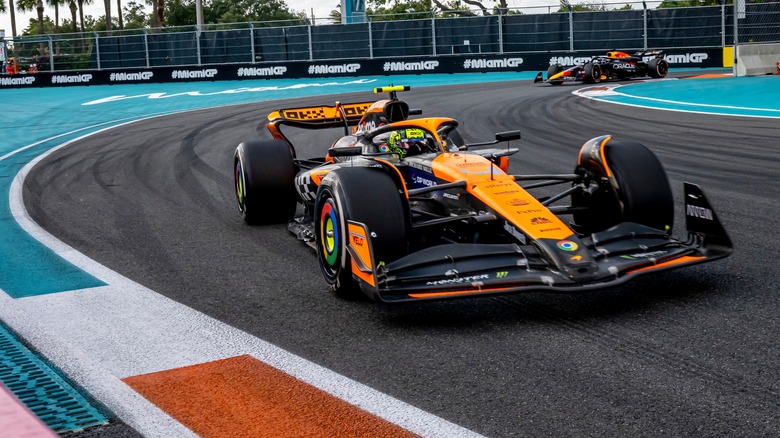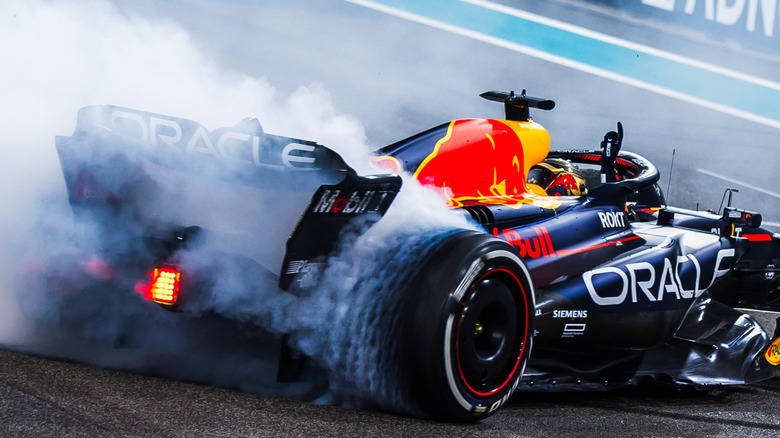Top Speed Vs. Acceleration: Which Is More Important In F1 Racing?
Modern F1 racing cars push man and machine to the limit, adopting advanced technologies and raw grit for a competitive edge. The sport has also never seemed more popular. Professional drivers are celebrities in their own right, with each championship galvanizing their namesake in the zeitgeist. But every driver has an immense team behind them, who may not be household names themselves, constantly working to ensure cars can rocket around the track. Engineers and car companies pour time, millions of dollars, and reputations into producing the fastest, most agile cars on the planet, in hopes of glory. There's a lot to learn about the sport of Formula 1 racing. However, many F1 enthusiasts often wonder just how much strategy goes into an engine's capabilities when it comes to top speed versus acceleration.
It's one thing to barrel down a straightaway at an eye-watering 200 miles per hour, compared to white-knuckling around a tight apex, mashing the gas pedal to dig out of corners. Neither the highest top speed nor the best acceleration alone wins races; rather, a combination of both acts as a sweet spot for an all-round, high-performing F1 car. A driver must harness this, and know how and when to push the limits to get on that podium. Here, we discuss which aspect of a race car's capability is more important in having an edge, and ultimately winning: top speed or acceleration.
The need for speed, and acceleration, too
The development of F1 racing never seems to plateau, with top speeds back in the late 1950s hitting 180 miles per hour — at the time, quite a feat. Years later, the first race car to break the 200-miles-per-hour barrier was the Lotus 49 in 1968. Fast forward 50 years, and F1 fans barely bat an eye at those top speeds, which are now considered normal. Juan Pablo Montoya claims the Guinness World Record of the highest top speed recorded at a Grand Prix, with a mind-bending 231.5 miles per hour speed, in 2005. As for acceleration, an F1 car can sprint to 60 miles per hour in a jaw-dropping 1.6 seconds, with averages in the range of 2.1 to 2.7 seconds considered normal.
But which aspect is more important in the pursuit of winning races — acceleration or top speed? The answer is neither. However, it's complicated by many variables, with acceleration potentially edging out top speed as more advantageous. A Formula 1 driver will typically experience G-forces of two when accelerating, which means the force pushing them into their seat is twice that of their body weight. Being able to accelerate so viciously means cars can gain or defend a track position, applying the maximum amount of throttle before the wheels lose grip. Perhaps the most crucial part of acceleration is exiting corners, where even carrying one or two miles per hour of extra pace provides advantages.
Symbiotic relationship: optimizing overall lap times
With engines putting out upward of 1000 horsepower, combined with the most advanced low-drag aerodynamics, modern F1 cars rocket around tracks in the blink of an eye. Having the ability to reach lightning-fast top speed and dig yourself out of tight corners, faster than your opponents, conspires to achieve track dominance. The question of top speed versus acceleration in Formula 1 is not a zero-sum game but rather an interconnected dynamic that, when both are maximized, achieves the fastest overall lap times. This is where a clear strategy comes into play, allowing the driver to leverage all of the work engineers and teams put into a vehicle for pole positioning.
As such, there is a symbiosis between the two aspects of a car's performance capabilities: Being fast in flat sections gets drivers to the corners faster, and being able to convert the engine's muscle into forward motion from slow speeds keeps you in front. What's certain is that a smart driver will leverage a car's capabilities to maximize speeds when flat out on straightaways or when winding through corners. It's not always about brute force — F1 races are about nuance and knowing when to punch it and when to ease back. Either way, the sport continues to thrill and excite with undeniable popularity and mind-blowing performances.


